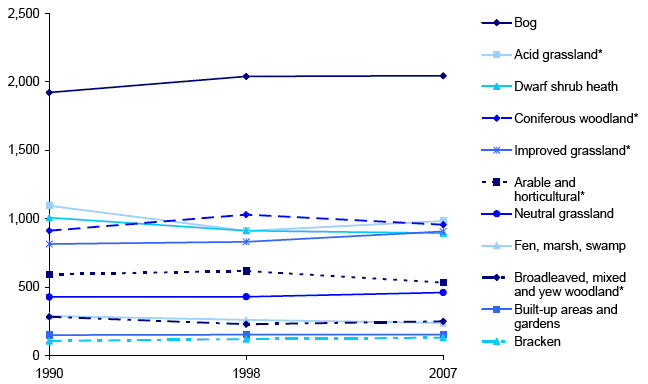Key Scottish Environment Statistics 2009
Annual publication containing summary of key statistics on environmental trends in Scotland
Land
Broad Habitat Change R: 1990-2007
Changes in the extents of the most widespread Broad Habitats (thousand hectares)

Area (thousand hectares)
Habitat |
1990 1 |
1998 |
2007 |
% Change (1998-2007) |
|---|---|---|---|---|
Acid grassland |
1,095 |
911 |
983 |
7.9* |
Coniferous woodland |
913 |
1,030 |
956 |
-7.1* |
Improved grassland |
815 |
831 |
907 |
9.1* |
Arable and horticultural land |
593 |
618 |
534 |
-13.6* |
Broadleaf, mixed and yew woodland |
284 |
229 |
251 |
9.5* |
(* statistically significant, p<0.05)
A classification of 'broad habitat' was defined for consistent reporting and monitoring of priority habitats that were identified under the UK Biodiversity Action Plan 2. The habitats range from developed land, such as built-up areas and gardens, to semi-natural land, such as grasslands, bog and bracken. The Countryside Survey 2007 3 reported the status of 19 of the 27 broad habitats occurring in Scotland. Changes in the extents of the 11 most widespread broad habitats are presented above.
Between 1998 and 2007 the area of broadleaved woodland, improved grassland and acid grassland increased. Coniferous woodland and arable and horticultural land decreased in the same time period. The area of the other broad habitats showed no significant change.
The largest change over the period 1998 to 2007 was in arable and horticultural land which decreased by nearly 84,000 hectares (13.6%). The largest increase in area of broad habitat was for acid grassland which increased by 72,000 hectares (7.9%) between 1998 and 2007, with most of this change being concentrated in the Scottish Uplands.
Source: Countryside Survey 2007
There is a problem
Thanks for your feedback